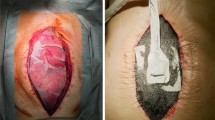Abstract
Background
Damage control surgery (DCS) has emerged as a new option in the management of non-traumatic peritonitis patients to increase survival in critically ill patients. The purpose of this study was to compare DCS with conventional strategy (anastomosis/ostomies in the index laparotomy) for severe non-traumatic peritonitis regarding postoperative complications, ostomy rate, and mortality and to propose a useful algorithm in the clinical practice.
Methods
Patients who underwent an urgent laparotomy for non-trauma peritonitis at a single level I trauma center in Colombia between January 2003 and December 2018, were retrospectively included. We compared patients who had DCS management versus definitive initial surgical management (DISM) group. We evaluated clinical outcomes and morbidities among groups.
Results
290 patients were included; 81 patients were treated with DCS and 209 patients underwent DISM. Patients treated with DCS had a worse critical status before surgery with higher SOFA score [median, DCS group: 5 (IQR: 3–8) vs. DISM group: 3 (IQR: 1–6), p < 0.001]. The length of hospital stay and overall mortality rate of DCS group were not significant statistical differences with DISM group. Complications rate related to primary anastomosis or primary ostomy was similar. There is not difference in ostomy rate among groups. At multivariate analysis, SOFA > 6 points and APACHE-II > 20 points correlated with a higher probability of DCS.
Conclusion
DCS in severe non-trauma peritonitis patients is feasible and safe as surgical strategy management without increasing mortality, length hospital of stay, or complications. DCS principles might be applied in the non-trauma scenarios without increase the stoma rate.


Similar content being viewed by others
References
Weber DG, Bendinelli C, Balogh ZJ (2014) Damage control surgery for abdominal emergencies. Br J Surg 101:e109–e118
Waibel BH, Rotondo MF (2012) Damage control for intra-abdominal sepsis. Surg Clin North Am 92:243–257
Ordoñez CA, Badiel M, Pino LF et al (2012) Damage control resuscitation: early decision strategies in abdominal gunshot wounds using an easy “ABCD” mnemonic. J Trauma Acute Care Surg 73:1074–1078. https://doi.org/10.1097/TA.0b013e31826fc780
Girard E, Abba J, Boussat B et al (2017) Damage control surgery for non-traumatic abdominal emergencies. World J Surg. https://doi.org/10.1007/s00268-017-4262-6
Gruen RL, Brohi K, Schreiber M et al (2012) Haemorrhage control in severely injured patients. Lancet 380:1099–1108. https://doi.org/10.1016/S0140-6736(12)61224-0
Voiglio EJ, Dubuisson V, Massalou D et al (2016) Abbreviated laparotomy or damage control laparotomy: Why, when and how to do it? J Visc Surg 153:13–24. https://doi.org/10.1016/j.jviscsurg.2016.07.002
Beldowicz BC (2018) The evolution of damage control in concept and practice. Clin Colon Rectal Surg 31:30–35. https://doi.org/10.1055/s-0037-1602177
Moore FA, McKinley BA, Moore EE (2004) The next generation in shock resuscitation. Lancet 363:1988–1996. https://doi.org/10.1016/S0140-6736(04)16415-5
Ordoñez C, Pino L, Badiel M et al (2012) The 1-2-3 approach to abdominal packing. World J Surg 36:2761–2766. https://doi.org/10.1007/s00268-012-1745-3
Stawicki SP, Brooks A, Bilski T et al (2008) The concept of damage control: extending the paradigm to emergency general surgery. Injury 39:93–101. https://doi.org/10.1016/j.injury.2007.06.011
Girard E, Abba J, Boussat B et al (2018) Damage control surgery for non-traumatic abdominal emergencies. World J Surg 42:965–973. https://doi.org/10.1007/s00268-017-4262-6
Morgan K, Mansker D, Adams DB (2010) Not just for trauma patients: damage control laparotomy in pancreatic surgery. J Gastrointest Surg 14:768–772. https://doi.org/10.1007/s11605-010-1186-y
Banieghbal B, Davies MR (2004) Damage control laparotomy for generalized necrotizing enterocolitis. World J Surg 28:183–186. https://doi.org/10.1007/s00268-003-7155-9
Coccolini F, Roberts D, Ansaloni L et al (2018) The open abdomen in trauma and non-trauma patients: WSES guidelines. World J Emerg Surg. https://doi.org/10.1186/s13017-018-0167-4
Ordóñez CA, Pineda JA, Arias RH et al (2008) Curso clínico de la peritonitis grave en pacientes críticamente enfermos tratados con sutura primaria diferida. Rev Colomb Cirugía 23:22–30
Ordóñez Delgado CA, Arias Gómez RH, Pineda Alzate JA et al (2006) Mortalidad y morbilidad de la peritonitis secundaria con relaparotomía planeada. Rev Colomb Cirugía 21:124–132
Ordóñez CA, Sánchez ÁI, Pineda JA et al (2010) Deferred primary anastomosis versus diversion in patients with severe secondary peritonitis managed with staged laparotomies. World J Surg 34:169–176. https://doi.org/10.1007/s00268-009-0285-y
Ordoñez CA, Puyana JC (2006) Management of peritonitis in the critically ill patient. Surg Clin North Am 86:1323–1349
R Core Team (2019) R: a language and environment for statistical computing
Khan A, Hsee L, Mathur S, Civil I (2013) Damage-control laparotomy in nontrauma patients. J Trauma Acute Care Surg 75:365–368. https://doi.org/10.1097/TA.0b013e31829cb65e
Ordoñez CA, Pino LF, Badiel M et al (2011) Safety of performing a delayed anastomosis during damage control laparotomy in patients with destructive colon injuries. J Trauma Inj Infect Crit Care 71:1512–1518
Tartaglia D, Costa G, Camillò A et al (2019) Damage control surgery for perforated diverticulitis with diffuse peritonitis: saves lives and reduces ostomy. World J Emerg Surg 14:19. https://doi.org/10.1186/s13017-019-0238-1
Gasser E, Alexander P, Reich-Weinberger S et al (2019) Damage control surgery for perforated diverticulitis: a two center experience with two different abdominal negative pressure therapy devices. Acta Chir Belg 119:370–375. https://doi.org/10.1080/00015458.2018.1534397
Bruns BR, Ahmad SA, Meara LO et al (2016) Nontrauma open abdomens: a prospective observational study. J Trauma Acute Care Surg 80:631–636. https://doi.org/10.1097/TA.0000000000000958
Kirkpatrick AW, Roberts DJ, Faris PD et al (2015) Active negative pressure peritoneal therapy after abbreviated laparotomy: the intraperitoneal vacuum randomized controlled trial. Ann Surg 262:38–46. https://doi.org/10.1097/SLA.0000000000001095
Author information
Authors and Affiliations
Corresponding author
Ethics declarations
Conflict of interest
The authors declare that they have no conflict of interest.
Animals or human rights
All procedures performed in studies involving human participants were in accordance with the ethical standards of institutional research committee from Fundación Valle del Lili under the number 554 in 2014 and has been updated annually since its approval.
Informed consent
Not applicable.
Additional information
Publisher's Note
Springer Nature remains neutral with regard to jurisdictional claims in published maps and institutional affiliations.
Rights and permissions
About this article
Cite this article
Ordoñez, C.A., Parra, M., García, A. et al. Damage Control Surgery may be a Safe Option for Severe Non-Trauma Peritonitis Management: Proposal of a New Decision-Making Algorithm. World J Surg 45, 1043–1052 (2021). https://doi.org/10.1007/s00268-020-05854-y
Accepted:
Published:
Issue Date:
DOI: https://doi.org/10.1007/s00268-020-05854-y




